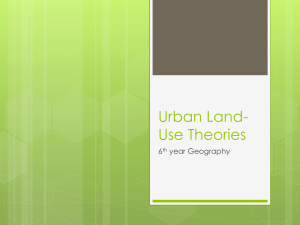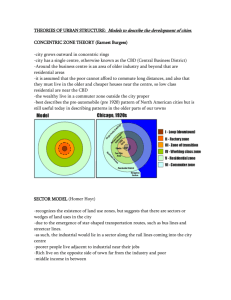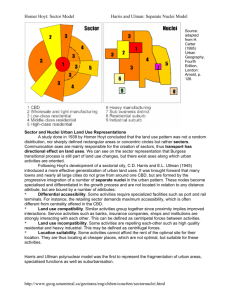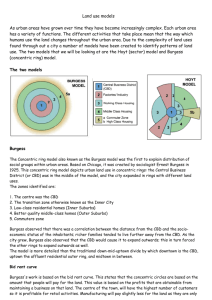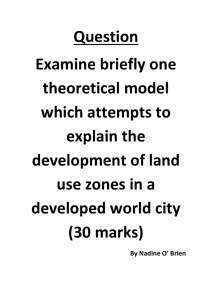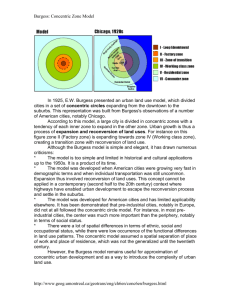Classic Urban Models - Caribbean Societies
advertisement
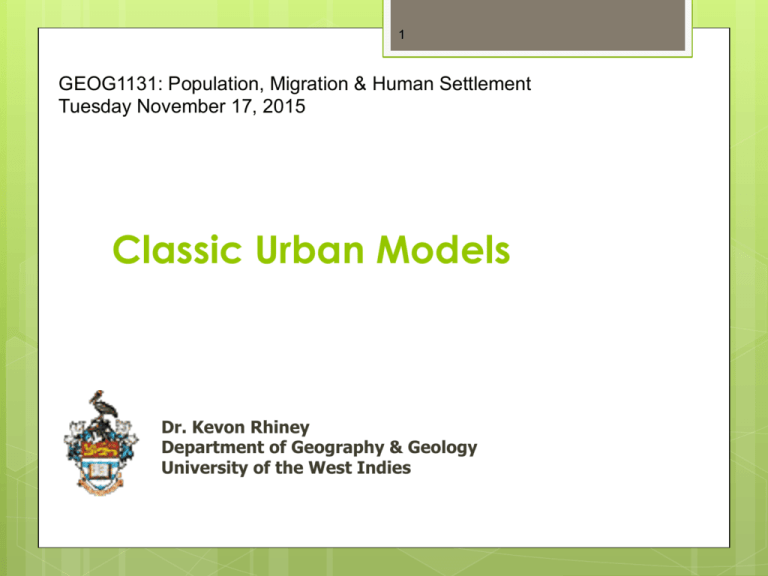
1 GEOG1131: Population, Migration & Human Settlement Tuesday November 17, 2015 Classic Urban Models Dr. Kevon Rhiney Department of Geography & Geology University of the West Indies 2 Classic Urban Models Concentric Zone Sector Model Multiple Nuclei 3 General aims Define, explain and discuss the various models of the internal structure of cities Relate urban land use to key geographic concepts Understand how land uses are shaped by land values Appreciate the interrelationship b/w the social and physical elements of the city 4 The Concentric Zone Model Burgess’s study of Chicago in the 1920s Chicago School Brought all the concepts together Logical Positivism 1886-1966 5 Underlying Processes in the Concentric Zone Model Based on plant ecology Invasion, competition, domination and succession When applied to groups of people living in urban areas these are called ‘urban ecological processes’ 6 The Concentric Zone Model Essentially an application of von Thunen’s model of agricultural land use The pattern of growth of a city can be understood in terms of six concentric zones lying beyond the immediate confines of the urban area. 7 8 Zone The 1: The Central Business District centre of commerce, transport, and social and civil life. Largest concentration of department stores, retail business, office buildings, banks, hotels, theatres, museums etc. Most accessible point of the city Land is intensively used; most expensive sites 9 Zone 2: The Wholesale Zone Fringe of CBD Dominated by wholesale activities Truck and railroad depots Cheaper land rents; less intense use of space Less traffic 10 Zone 3: Zone in Transition/working class housing Residential deterioration Characterised by slum settlements First-generation immigrants Business and retail interspersed with lowincome housing Businesses are attracted to this zone due to the demand for their goods and the supply of cheap labour 11 Zone 4: Middle Class Housing Consists primarily of the residences of individual workers who have escaped the blight in the transition zone Second-generation immigrants and families Small yard spaces 12 Zones 5 and 6: High Class Housing / Commuter Zone Single-family units Larger land spaces High-income apartment buildings Suburbs; satellite towns Correlation between socio-economic status and distance from city centre. 13 Criticisms of Concentric Model Too simplistic and limited in historical and cultural applications; limited applicability elsewhere Based only on American cities A product of its time The Sector Model Formulated by Homer Hoyt Also a Logical Positivists 1962 The Sector Model The model is essentially complementary to that of Burgess rather than being mutually exclusive However, Burgess was a sociologist while Hoyt was an economist Hoyt was more concerned with examining how the housing market operated in order to advise the American government on housing policy The Sector Model Primarily concern with the location of high-rent neighbourhoods Nevertheless, the model has implications for other housing types Used rental value as an indicator for housing quality Hoyt demonstrated how residential land uses tend to be arranged in the form of sectors radiating outward from the city centre along transportation routes. Conclusions reached by Hoyt The High-rental areas are located on one side of the city; often in peripheral locations, but may at times extend continuously from the city centre High-rent areas often take the form of wedges, extending in certain areas sectors along radial lines outward from the city centre to the periphery Conclusions reached by Hoyt Middle-range residential areas tend to be located on either side of the highest rental areas There are some cities in which large areas of middle-range neighbourhoods are found on the periphery of low-rent residential areas, as well as on both sides of high-rental areas All cities have low-rent areas and these are frequently found opposite the location of high-rent areas and usually in the more central locations The Multiple Nuclei Model Developed in 1945 by Harris and Ullman Critic of the concentric zone and the sector models Argument: In most cities, land uses are not built around a single centre, but around several discrete nuclei In some cities these nuclei have existed from the very origin of the city; in others, they have developed as the growth of the city stimulated migration and specialization ¨ The following can be noted with respect to the multiple nuclei model: ¤ The heavy manufacturing/industrial areas are located on the outskirts of the city ¤ The minor nuclei include cultural centres, parks, outlying business districts and small industrial centres. A university may be the nucleus for a semi-independent community. ¤ The existence of suburbs is characteristic of most large American cities. ¤ The larger and older a city, the more numerous and specialised its nuclei Factors explaining the rise of separate nuclei: 1. 2. 3. 4. Certain activities require specialised facilities. Certain related activities cluster together because they profit from cohesion (e.g. greater economies of scale) Certain activities are detrimental to each other; incompatible land uses e.g. heavy manufacturing and high-class residential development. Certain activities are unable to afford the high rents of the most desirable sites. Concluding thoughts Think about which one of these models best relates to the towns and cities with which you are familiar In most cases, elements of more than one model may be evident; particularly since the models are not mutually exclusive.
